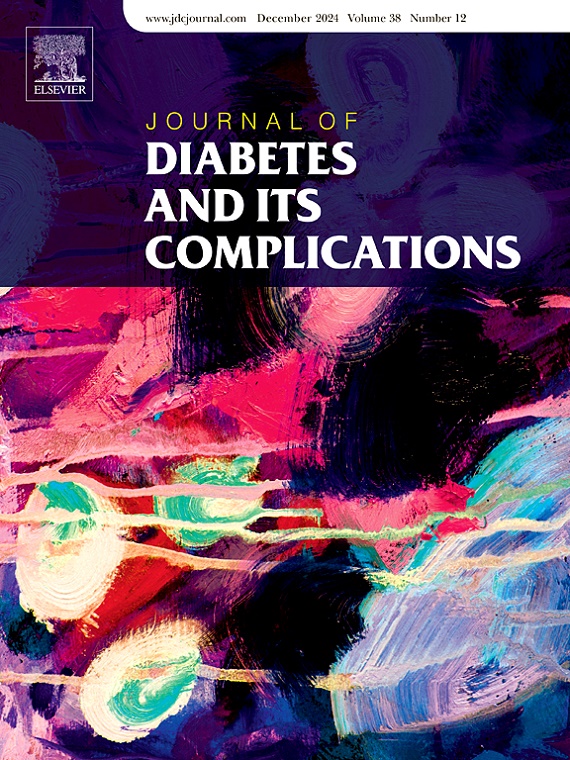成人1型糖尿病患者饮食失调亚型及其糖尿病相关和社会心理并发症
IF 3.1
3区 医学
Q3 ENDOCRINOLOGY & METABOLISM
引用次数: 0
摘要
目的确定1型糖尿病患者饮食失调行为(DEB)亚型,描述其行为模式、临床特征、社会心理健康和糖尿病相关并发症。方法分析1型糖尿病患者饮食行为紊乱和饮食失调(DEBBI)研究的基线数据(N = 645)。参与者完成了评估DEB、糖尿病相关结果和社会心理健康的问卷。基于dps - r指标的潜在特征分析确定了亚型,随后比较了人口统计学、临床和社会心理变量。结果发现四种不同的DEB亚型,其强度和行为特征不同:抑制饮食(中度DEB)、去抑制饮食(中度DEB)、维持高糖(重度DEB)和双重代偿行为(重度DEB)。所有DEB亚型都报告了显著较差的社会心理健康状况,包括糖尿病痛苦加重、对低血糖的恐惧、抑郁和焦虑。严重的DEB亚型表现出较差的糖尿病自我管理和较高的HbA1c水平。结论1型糖尿病患者DEB表现的多样性强调了检查特定行为模式的必要性。这些亚型显示出不同的临床特征、行为模式和自我管理质量的变化,表明有害的DEB不仅仅局限于胰岛素净化。即使是中等形式的DEB也与严重的社会心理负担有关,这突出了早期发现和干预的重要性。本文章由计算机程序翻译,如有差异,请以英文原文为准。
Subtypes of disordered eating and their diabetes-related and psychosocial concomitants in adults with type 1 diabetes
Aims
To identify subtypes of disordered eating behaviors (DEB) in type 1 diabetes, describing their behavioral patterns, clinical features, psychosocial well-being, and diabetes-related complications.
Methods
Baseline data of the Disordered Eating Behaviors and Eating Disorders in Diabetes Type I (DEBBI) study were analyzed (N = 645). Participants completed questionnaires assessing DEB, diabetes-related outcomes, and psychosocial well-being. Latent profile analysis identified subtypes based on DEPS-R indicators, followed by comparisons of demographic, clinical, and psychosocial variables.
Results
Four distinct DEB subtypes were identified, that differed in intensity and behavioral characteristics: restrained eating (moderate DEB), disinhibited eating (moderate DEB), maintaining high glucose (severe DEB), and dual compensatory behaviors (severe DEB). All DEB subtypes reported significant poorer psychosocial well-being, including elevated diabetes distress, fear of hypoglycemia, depression, and anxiety. The severe DEB subtypes showed poorer diabetes self-management and higher HbA1c levels.
Conclusions
The diversity of DEB presentations in type 1 diabetes underscores the need to examine specific behavioral patterns. The subtypes revealed distinct clinical features, behavioral patterns, and variations in self-management quality, demonstrating that harmful DEB extends beyond insulin purging alone. Even moderate forms of DEB were linked to significant psychosocial burden, highlighting the importance of early detection and intervention.
求助全文
通过发布文献求助,成功后即可免费获取论文全文。
去求助
来源期刊

Journal of diabetes and its complications
医学-内分泌学与代谢
CiteScore
5.90
自引率
3.30%
发文量
153
审稿时长
16 days
期刊介绍:
Journal of Diabetes and Its Complications (JDC) is a journal for health care practitioners and researchers, that publishes original research about the pathogenesis, diagnosis and management of diabetes mellitus and its complications. JDC also publishes articles on physiological and molecular aspects of glucose homeostasis.
The primary purpose of JDC is to act as a source of information usable by diabetes practitioners and researchers to increase their knowledge about mechanisms of diabetes and complications development, and promote better management of people with diabetes who are at risk for those complications.
Manuscripts submitted to JDC can report any aspect of basic, translational or clinical research as well as epidemiology. Topics can range broadly from early prediabetes to late-stage complicated diabetes. Topics relevant to basic/translational reports include pancreatic islet dysfunction and insulin resistance, altered adipose tissue function in diabetes, altered neuronal control of glucose homeostasis and mechanisms of drug action. Topics relevant to diabetic complications include diabetic retinopathy, neuropathy and nephropathy; peripheral vascular disease and coronary heart disease; gastrointestinal disorders, renal failure and impotence; and hypertension and hyperlipidemia.
 求助内容:
求助内容: 应助结果提醒方式:
应助结果提醒方式:


